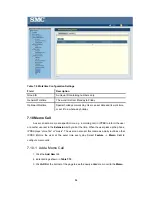
69
ranges from 1 to 32. It should not overlap with existing
PSTN trunk groups.
Trunk Type
Select the port type, FXO or FXS. If selecting FXS,
users can see
By Number
and
By Privilege
in the
DID
of Extension
list, and be able to configure
DID Prefix
and
DID Stripping
.
Trunk Ports
FXO and FXS port indices grouped by this PSTN trunk,
such as 1 or 1,2 or 1-3, etc. Maximum port index
depends on the number of physical ports available.
Description
Arbitrary description information.
Port Selection
Click to search for an available port in the group.
Rotating
means to force ports being selected by turns
to even cost.
Caller ID Detection
Select to detect the Caller ID calling from PSTN lines.
Answering by Battery Reversal
Detection
If the PSTN service provides battery reversal, select to
count billable time starting from the call is answered.
#
Clear the check box, if you are not sure whether the
PSTN service provides the function.
DID of Extension
When enabled DID, clicks an extension in the list to be
an unconditional destination for incoming calls to this
trunk. The PSTN numbers of the included ports are
therefore regarded as the direct line numbers of the
extension. If
FXS
is selected in the
Trunk Type
list, you
can also click
By Number
or
By Privilege
, and then
enter configurations in
DID Prefix
and
DID Stripping
to have the incoming calls directed to the
corresponding extension or trunk derived by number
manipulation. The PSTN trunk numbers is therefore
regarded as the direct line of the extension.
#
If you set a DID extension in trunk, then only that
extension can use this trunk to call out, and all
other user’s call in this trunk will connect to that
extension.
#
If selecting
By Number
, the "number" being
manipulated for extension DID is the called
(destination) number. As a result, one should
confirm what prefix, usually the area code, would
Summary of Contents for PBX10 FICHE
Page 1: ...SMCPBX10 TigerVoIP IP PBX Telephony System USER GUIDE TM...
Page 2: ......
Page 132: ...SMCPBX10...



































